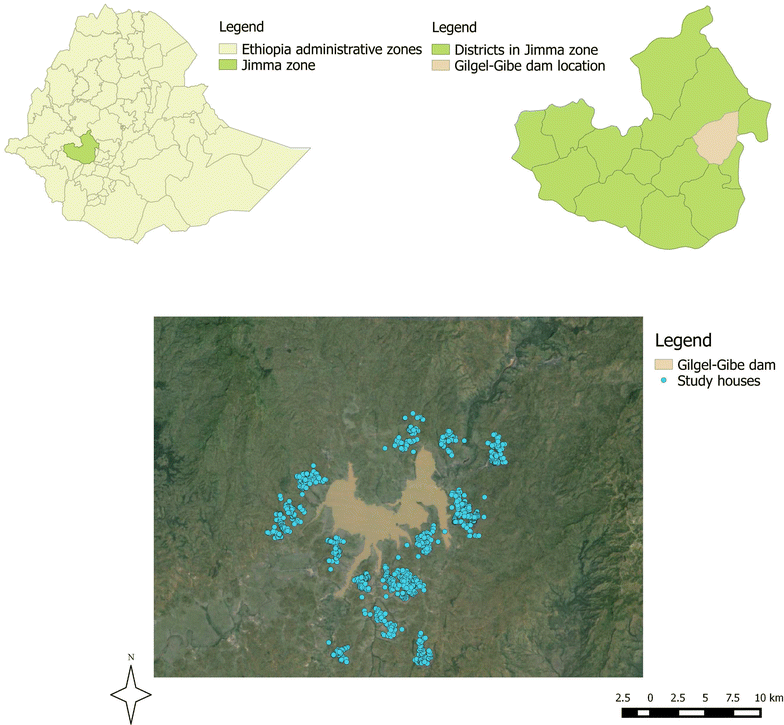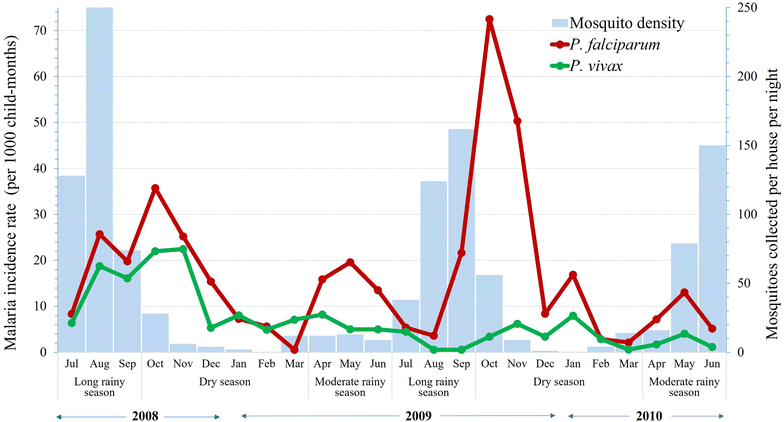Identification of different malaria patterns due to Plasmodium falciparum and Plasmodium vivax in Ethiopian children: a prospective cohort study
- PMID: 27075667
- PMCID: PMC4831103
- DOI: 10.1186/s12936-016-1253-2
Identification of different malaria patterns due to Plasmodium falciparum and Plasmodium vivax in Ethiopian children: a prospective cohort study
Abstract
Background: The identification of epidemiological pattern of infection with Plasmodium falciparum and Plasmodium vivax in malaria-endemic area, where multiple episodes are common, is important for intervention programmes.
Methods: A longitudinal cohort study based on weekly house-to-house visits was conducted between July 2008 and June 2010 in 2040 children less than 10 years of age, living nearby the Gilgel-Gibe hydroelectric power dam reservoir in order to determine factors associated with increased P. vivax and P. falciparum incidence. Two types of multivariate frailty models were applied (using time-to-first malaria episode data and time-to-recurrent malaria episode data), allowing the estimation of adjusted hazard ratios (AHR) of potential risk factors (gender, age, proximity to the dam reservoir, and season) for species-specific malaria incidence.
Results: Of 2040 children in 96 weeks of follow up, 864 children experienced at least one malaria episode: 685 due to P. falciparum in 548 children, and 385 due to P. vivax in 316 children. Plasmodium vivax and P. falciparum malaria incidence rates were 8.2 (95 % CI: 7.3-9.1) and 14.6 (95 % CI: 13.4-15.6) per 1000 children per month, respectively. According to the time-to-recurrent event models, children aged ≥7 years had a lower risk of presenting P. vivax episodes (AHR = 0.6; 95 % CI: 0.4-0.9), but a higher risk of P. falciparum episodes, when compared with children under ≤3 years (AHR = 1.2; 95 % CI: 1.1-1.6). In addition, P. vivax (AHR = 2.7; 95 % CI: 2.2-3.5) and P. falciparum (AHR = 16.9; 95 % CI: 14.3-20.2) episodes were respectively 2.7 and 16.9 times more frequent in the dry season than in the long rainy season.
Conclusions: The analysis of all malaria episodes (first and recurrent episodes) in the malaria cohort suggests different species-specific patterns of malaria disease in children, with mild seasonality in the incidence of P. vivax episodes mostly observed in younger age groups, and with marked seasonality in the incidence of P. falciparum episodes mainly seen in older children.
Keywords: Ethiopia; Frailty model; Plasmodium falciparum; Plasmodium vivax; Recurrent malaria.
Figures
Similar articles
-
Household level spatio-temporal analysis of Plasmodium falciparum and Plasmodium vivax malaria in Ethiopia.Parasit Vectors. 2017 Apr 20;10(1):196. doi: 10.1186/s13071-017-2124-6. Parasit Vectors. 2017. PMID: 28427451 Free PMC article.
-
Dynamics of Plasmodium falciparium and Plasmodium vivax in a micro-ecological setting, Southwest Ethiopia: effects of altitude and proximity to a dam.BMC Infect Dis. 2014 Nov 19;14:625. doi: 10.1186/s12879-014-0625-x. BMC Infect Dis. 2014. PMID: 25407982 Free PMC article.
-
Older children are at increased risk of Plasmodium vivax in south-central Ethiopia: a cohort study.Malar J. 2021 Jun 6;20(1):251. doi: 10.1186/s12936-021-03790-3. Malar J. 2021. PMID: 34092235 Free PMC article.
-
Plasmodium vivax in the Era of the Shrinking P. falciparum Map.Trends Parasitol. 2020 Jun;36(6):560-570. doi: 10.1016/j.pt.2020.03.009. Epub 2020 Apr 22. Trends Parasitol. 2020. PMID: 32407682 Free PMC article. Review.
-
Prevalence and risk factors related to poor outcome of patients with severe Plasmodium vivax infection: a systematic review, meta-analysis, and analysis of case reports.BMC Infect Dis. 2020 May 24;20(1):363. doi: 10.1186/s12879-020-05046-y. BMC Infect Dis. 2020. PMID: 32448216 Free PMC article.
Cited by
-
Epidemiological profiles of recurrent malaria episodes in an endemic area along the Thailand-Myanmar border: a prospective cohort study.Malar J. 2019 Apr 8;18(1):124. doi: 10.1186/s12936-019-2763-5. Malar J. 2019. PMID: 30961583 Free PMC article.
-
The relative impact of interventions on sympatric Plasmodium vivax and Plasmodium falciparum malaria: A systematic review.PLoS Negl Trop Dis. 2022 Jun 29;16(6):e0010541. doi: 10.1371/journal.pntd.0010541. eCollection 2022 Jun. PLoS Negl Trop Dis. 2022. PMID: 35767578 Free PMC article.
-
A 17-year trend analysis of malaria at Adi Arkay, north Gondar zone, Northwest Ethiopia.Malar J. 2018 Apr 6;17(1):155. doi: 10.1186/s12936-018-2310-9. Malar J. 2018. PMID: 29625586 Free PMC article.
-
Long-Lasting Insecticide Net Ownership, Access and Use in Southwest Ethiopia: A Community-Based Cross-Sectional Study.Int J Environ Res Public Health. 2017 Oct 27;14(11):1312. doi: 10.3390/ijerph14111312. Int J Environ Res Public Health. 2017. PMID: 29077052 Free PMC article.
-
Using Rainfall and Temperature Data in the Evaluation of National Malaria Control Programs in Africa.Am J Trop Med Hyg. 2017 Sep;97(3_Suppl):32-45. doi: 10.4269/ajtmh.16-0696. Am J Trop Med Hyg. 2017. PMID: 28990912 Free PMC article.
References
-
- WHO . World Malaria Report 2015. Geneva: World Health Organization; 2015.
-
- Nigatu W, Abebe M, Dejene A. Plasmodium vivax and P. falciparum epidemiology in Gambella, south-west Ethiopia. Trop Med Parasitol. 1992;43:181–185. - PubMed
Publication types
MeSH terms
LinkOut - more resources
Full Text Sources
Other Literature Sources



